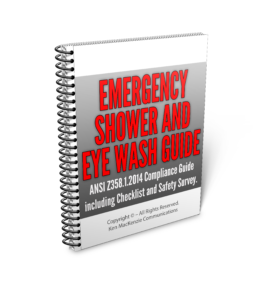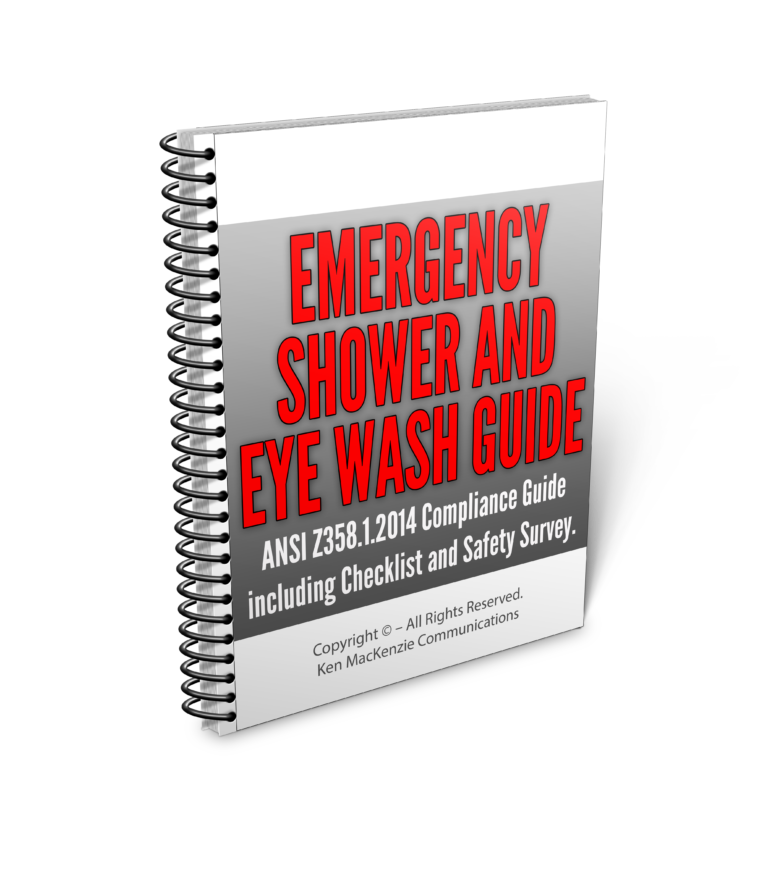Table of Contents
Safety Shower Requirements – How to Comply
OSHA financial penalties for ANSI Z358.1 2014 non compliance of safety shower requirements have increased significantly.
Simply providing a safety shower and/or eye wash is not enough.
In fact, to comply with the Occupational Safety and Health Administration law and be ANSI Z358.1 2014 compliant there are now three significant changes that are required.
- Most companies have the wrong water temperature and therefore are not compliant.
- If you have a combination shower and eye wash then you need to know the simultaneous use and the minimum flow rate requirements.
- Testing requirements and how to stay compliant are now major considerations.
Most emergency shower and eye wash/face wash units across North America do not comply with these significant code provisions.
In North America, the Occupational Safety and Health Administration (OSHA) and the Canadian Centre for Occupational Health and Safety (CCOHS) commonly refer to ANSI/ISEA Z358.1-2014.
To be sure your business is compliant you should conduct a Safety Audit Survey. A Safety Audit Survey will save you money because if your business is not prepared a lawsuit could follow.
A single workplace accident can be devastating. Someone can be injured… or even killed. Property, equipment or materials can be damaged or destroyed. And work could come to a complete standstill. All of these things can happen if efforts are not made to protect employees. One way to accomplish this is to conduct a safety audit.
Safety Audit Topics should cover:
- A workplace analysis.
- Administrative controls.
- Engineering controls.
- Personal protective equipment.
- Emergency response procedures.
- Regulatory compliance, safety and health training.
- Accident investigation.
- A safety self-assessment.
and more
Questions to Ask Relating to Osha Safety Shower Requirements:
- Do you know who is responsible and who assigns responsibility ?
- Are you prepared and, do you have an Emergency Action Plan ?
- Are you aware and have a Hazardous Substance Control Program ?
- There’s no price tag on the loss of vision or pain and suffering associated with eye and other corrosive splash injuries !
- Every employer must organize the necessary staff training on how to use the Eye Wash and Emergency Shower facilities to ensure their employees are safe.
Remember, even if you have the equipment installed that does not mean they are safe.
The Emergency Shower and Eye Wash Guide provides a checklist to help you identify some of the significant ANSI shower requirements included in ANSI Z358.1.
The Guide explains what employers are required to provide in eye wash and safety shower stations by OSHA and how to comply with ANSI Z358.1 2014.
Its critical that you realise that compliance is essential for risk mitigation in today’s lawsuit business climate.
Here are some ANSI emergency showers requirements and eye wash questions that need answering:
- What is considered a flushing liquid?
- How long should contact area be rinsed/flushed ?
- What type of equipment to install ?
- What specifications should equipment meet ?
- Where should emergency shower and eye wash station equipment be located?
- What temperature should the water be?
- When should emergency shower and eye wash station equipment be inspected ?
Many companies do not know these emergency shower requirements and, it could mean you’re at risk of huge financial penalties !
The first 10 seconds after exposure to a hazardous substance are critical.
You must carry out a regular testing and maintenance program. Weekly activation is an important step in the maintenance of your safety shower and eyewashes. Activation is just another way to say “turn it on.” It’s important because it ensures that fluid doesn’t get stagnant and is available to the head of the unit – the part where the water comes out. It’s also helpful in clearing the water line of any build-up that could clog it
The ANSI safety shower requirements stipulate that where the eyes or body of any person may be exposed to injurious corrosive materials, suitable facilities for quick drenching or flushing of the eyes and body shall be provided within the work area for immediate emergency use.
As an employer you have the important responsibility of understanding and complying with OSHA and ANSI guidelines for emergency shower requirements and eye washes. While selecting the right emergency shower and/or eye wash stations for your facility may appear difficult, it is really quite simple once you familiarize yourself with a few simple criteria.
Once you understand the safety shower requirements, you will be well on your way to developing an emergency eyewash and shower compliance program tailored to your facility’s needs.
Types of Emergency Response Equipment:
1. Emergency Eye/Face Wash Equipment
2. Mobile Emergency Safety Showers
3. Indoor Emergency Safety Showers
4. Outdoor Emergency Safety Showers
5. Temperature Controlled Emergency Safety Showers
6. Emergency Tank Showers
The Emergency Shower Requirements and Eye Wash Guide should be a great start to keep you and your employees safe from harm – and your wallet safe from monetary citations.


